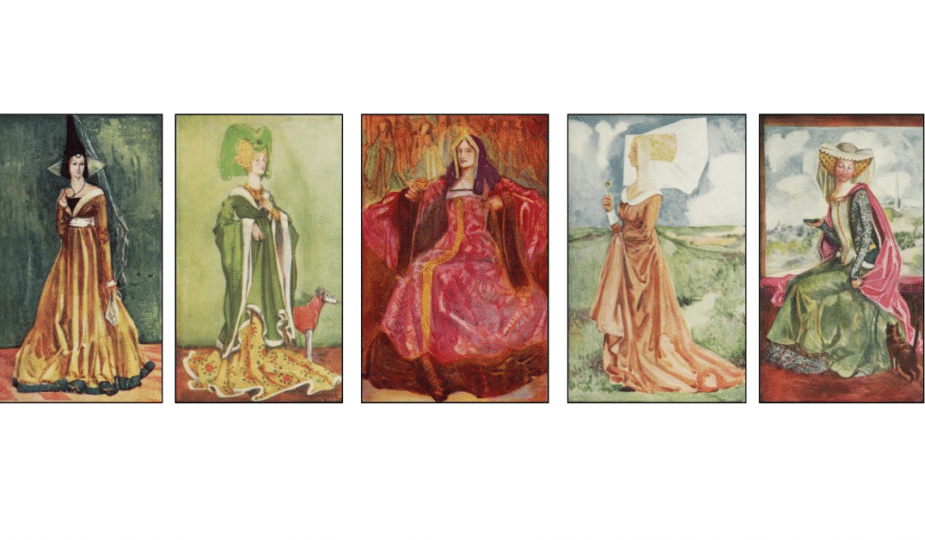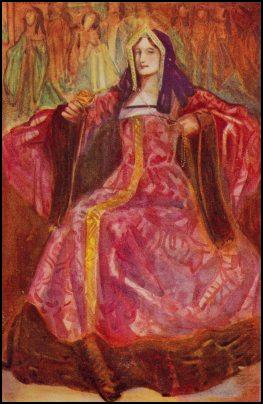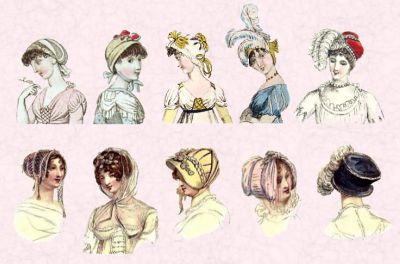English Costume by Dion Clayton Calthrop
Edited By Pauline Weston Thomas For Fashion-Era.com

1327-1485 - Women's Hair & Headdresses As Shown In
'English Costume History by Dion Clayton Calthrop'
This costume history page is about hair fashion history. It consists of a selection of women only headdresses and hairstyle illustrations with original text from 1327 to 1485 and taken from Calthrop's English Costume.
They are as shown in individual Calthrop costume pages for specific eras on 36 other pages in another section of this website. The partial text copy is from the book ENGLISH COSTUME PAINTED & DESCRIBED BY DION CLAYTON CALTHROP.Full text is on the individual dated pages.
This page is about female headdresses and hairdressing styles for the medieval era 1327 - 1485. Later eras of headdresses are shown on other pages. For the Introduction to this book see this introduction written by Dion Clayton Calthrop.
My comments are in italics.
EDWARD THE THIRD 1327-1377. Born 1312. Married, 1328, Philippa of Hainault.
14th Century Women's Hair 1327-1377
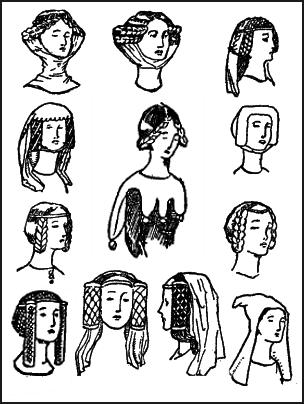
The noteworthy point about a woman of this reign was her hair.
The Queen herself wore an elaborate mode of coiffure for that time; she wore a metal fillet round her head, to which was attached two cases, circular in shape, of gold fretwork, ornamented with precious stones.
She wore her hair unplaited, and brought in two parts from the back of her head, and as far as one can see, pushed into the jewelled cases.
The most general form of hair-dressing was an excess on the mode of the previous reign, a richness of jewel-work, an abundance of gold wire.
It was usual to divide the hair into two plaits, and arrange these on either side of the face, holding them in their place by means of a fillet; they might be worn folded straight up by the face, or at an angle, but they were never left hanging; if hair was left loose it was not plaited, but flowing.
The Gorget 1327-1377
The gorget, or throat cloth, was still in general use, and it was attached to the hair by very elaborate-headed pins. Sometimes the hair, dressed with the gorget, was divided into four plaits, two on either side of the face, and fastened horizontally.
The Wimple 1327-1377
The wimple of silk or linen was very generally worn.
A Hair Caul of Gold Net
A caul of gold net came into fashion, but not until the end of the reign. The ladies were great upon hunting and hawking, and this must have been a convenient fashion to keep the hair in order.
Some wore a white silk or linen cap, so shaped as to include and cover the two side-plaits and combine a gorget and wimple in one. Pointed frontals of pearls were worn across the forehead, and fillets of silk or linen were so tied that long ends hung down the back.
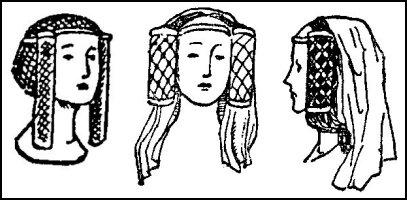
Yellow Hair
Yellow hair was much esteemed, and ladies who were not favoured by Nature, brought saffron to their aid, and by such efforts brought Nature into line with Art.
HAIR IN REIGN OF RICHARD THE SECOND
1377-1399 Married, 1381 To Anne of Bohemia; 1395 To Isabella of France.
THE WOMEN Medieval Hair Fashions
If ever women were led by the nose by the demon of fashion it was at this time. Not only were their clothes ill-suited to them, but they abused that crowning glory, their hair.
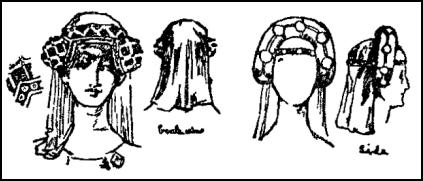
Calthrop continues to write:- No doubt a charming woman is always charming, be she dressed by woad or worth; but to be captivating with your eyebrows plucked out, and with the hair that grows so prettily low on the back of the neck shaved away - was it possible? I expect it was.
The days of high hennins was yet to come; the day of simple hair-dressing was nearly dead, and in the interval were all the arts of the cunning devoted to the guimpe, the gorgières, the mentonnières, the voluminous escoffions.
Hair Fashions - Chaplets
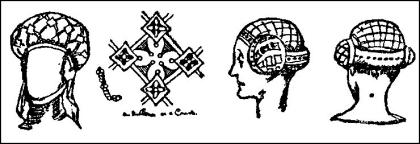
At this time the lady wore her hair long and hanging freely over her shoulders; her brows were encircled by a chaplet, or chapel of flowers, real or artificial, or by a crown or plain circlet of gold; or she tucked all her hair away under a tight caul, a bag of gold net enriched with precious stones.
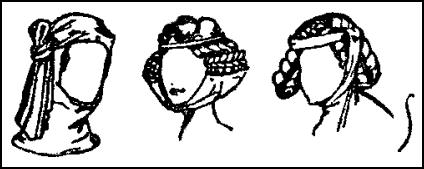
C14th Hair Fashions - Wimple, Caul & Dorelet
To dress hair in this manner it was first necessary to plait it in tight plaits and bind them round the head, then to cover this with a wimple, which fell over the back of the neck, and over this to place the caul, or, as it was sometimes called, the dorelet.
Now and again the caul was worn without the wimple, and this left the back of the neck exposed; from this all the hair was plucked.
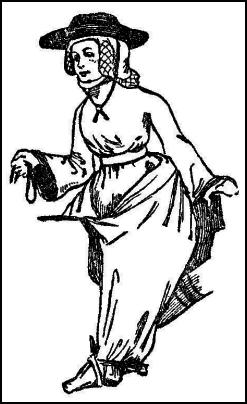
For outdoor exercises the lady would wear the chaperon, and upon this the peaked hat.
It is almost impossible to describe clearly the head-dresses - the great gold net bags which encased the hair - for they were ornamented in such different ways, always, or nearly always, following some pattern in diaper in contrast to the patterns which came later when the design followed such lines as are formed by wire-netting, while later still the connecting-thread of the patterns was done away with and the inside decoration alone remained.
THE WIFE OF BATH
Her wimples of fine linen -
'I dorste swere they weyeden ten pound
That on a Sonday were upon hir heed.'
Her hose was of fine scarlet red; her shoes were moist and new. Her hat was as broad as a buckler, and she wore a foot-mantle about her hips.
§
A Woman's Caul Headress in Medieval
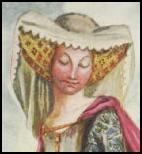 Calthrop sates:- Certain it is that in this reign the close caul grew out of all decent proportions, and swelled into every form of excrescence and protuberance, until in the reign of Henry VI, it towered above the heads of the ladies, and dwarfed the stature of the men.
Calthrop sates:- Certain it is that in this reign the close caul grew out of all decent proportions, and swelled into every form of excrescence and protuberance, until in the reign of Henry VI, it towered above the heads of the ladies, and dwarfed the stature of the men.
This curious head-gear, the caul, after a modest appearance, as a mere close, gold-work cap, in the time of Edward III, grew into a stiffer affair in the time of Richard II, but still was little more than a stiff sponge-bag of gold wire and stuff and a little padding; grew still more in the time of Henry IV, and took squarer shapes and stiffer padding; and in the reign of Henry V, it became like a great orange, with a hole cut in it for the face - an orange which covered the ears, was cut straight across the forehead, and bound all round with a stiff jewelled band.
Then came the idea of the horn.
We see the caul grow from its circular shape into two box forms on either side of the head; the uppermost points of the boxes are arranged in horns, whose points are of any length from 4 to 14 inches.
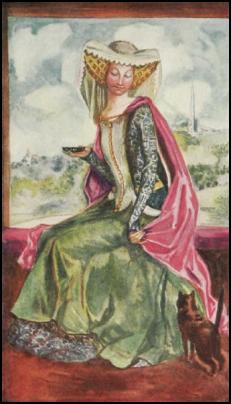
The top of this head-dress is covered with a wimple, which is sometimes stiffened with wires.
A WOMAN OF THE TIME OF HENRY V - 1413-1422
Her surcoat is stiffened in front with fur and shaped with a band of metal. Her belt is low on the hips of the under-dress. The horns on her head carry the large linen wimple.
There is also a shape something like a fez or a flower-pot, over which a heavy wimple is hung, attached to this shape; outside the wimple are two horns of silk, linen, or stuff - that is, silk bags stuffed to the likeness of horns.
Cathrop states that very few of these very elaborate horn head-dresses were worn at this time with the mass of women wearing the round caul.
THE WOMEN 1413-1422 High Towering Headdresses
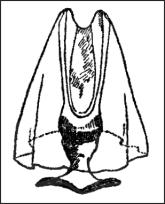
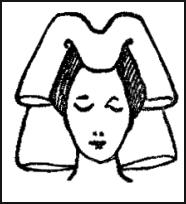
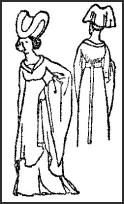
Calthrop writes:- The heads of these ladies are carried very erect, as are all heads bearing weights. The waists of these ladies are apparently under their bosoms; their feet seem to be an ell long.
An assembly hour is, after the manner of Lydgate's poem, a dream of delicious faces surmounted by minarets, towers, horns, excrescences of every shape - enormous, fat, heart-shaped erections, covered with rich, falling drapery, or snow-white linen, or gold tissue; gold-wire boxes sewn with pearls and blazing with colours; round, flat-topped caps, from under which girls' hair escapes in a river of colour; crown shapes, circular shapes, mitre shapes, turbans, and shovel-shaped linen erections, wired into place.
And the moralists, among whom Heaven forbid that I should be found, painted lurid pictures for you of hell and purgatory, in which such head-dresses turned into instruments of torture; you lifted your long-fingered, medieval hand and shook the finger with the toad-stone upon it, as if to dispel the poison of their words.
I think it is beyond me to describe in understandable terms the proper contortions of your towered heads, for I have little use for archaic words, for crespine, henk, and jacque, for herygouds with honginde sleeves, for all the blank cartridges of antiquarianism. I cannot convey the triple-curved crown, the ear buttress, the magnet-shaped roll in adequate language, but I can draw them for you.
Calthrop's - How to Make A Medieval Headdress 1413-1422
Calthrop's Late Medieval Headdress Pattern Instructions
I will attempt the most popular of the roll head-dresses and the simpler of the stiff-wired box.
Popular Medieval Roll Headdresses
Take a roll, stuffed with hemp or tow, of some rich material and twist it into the form of a heart in front and a shape behind, where join the ends, or, better, make a circle or hoop of your rolled stuff and bend it in this way.
Then make a cap that will fit the head and come over the ears, and make it so that this cap shall join the heart-shaped roll at all points and cause it to appear without any open spaces between the head and the roll; the point of the heart in front will be round, and will come over the centre of the face.
By joining cap and roll you will have one complete affair; over this you may brooch a linen wimple or a fine piece of jagged silk. In fact, you may twist your circle of stuff in any manner, providing you keep a vague shape in front and completely cover the hair behind.
The Stiff Wired Box Gold Criss Cross Box Patterned Headdress 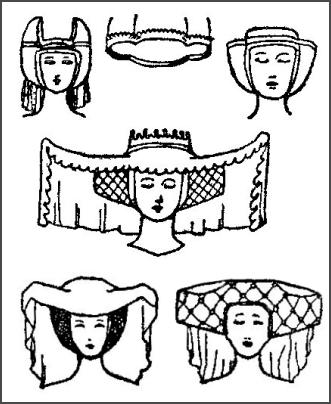
1413-1422
For the box pattern it is necessary to make a box, let us say of octagonal shape, flat before and behind, or slightly curved; cut away the side under the face, or leave but a thin strip of it to go under the chin.
Now stuff your box on either side of the face and cut away the central square, except for 3 inches at the top, on the forehead; here, in this cut-away piece, the face shows.
You will have made your box of buckram and stuffed the wings of it with tow; now you must fit your box to a head and sew linen between the sides of the head and the tow to hold it firm and make it good to wear.
You have now finished the rough shape, and you must ornament it.
Take a piece of thin gold web and cover your box, then get some gold braid and make a diaper or criss-cross pattern all over the box, leaving fair sized lozenges; in these put, at regular intervals as a plain check, small squares of crimson silk so that they fit across the lozenge and so make a double pattern.
Now take some gold wire or brass wire and knot it at neat intervals, and then stitch it on to the edges of the gold braid, after which pearl beads may be arranged on the crimson squares and at the cross of the braid; then you will have your box-patterned head-dress complete.
C15th Horn Headdress 1413-1422
Calthrop suggests on this for more ornate versions.
Calthrop suggests improvements on this for more ornate versions.
It remains for you to enlarge upon this, if you wish, in the following manner: take a stiff piece of wire and curve it into the segment of a circle, so that you may bend the horns as much or as little as you will, fasten the centre of this to the band across the forehead, or on to the side-boxes, and over it place a large wimple with the front edge cut.
Again, for further enhancement of this delectable piece of goods, you may fix a low gold crown above all - a crown of an elliptical shape - and there you will have as much magnificence as ever graced lady of the fifteenth century.
A WOMAN OF THE TIME OF HENRY VI -1422-1461 - Right
Her head-dress is very high, and over it is a coloured and jagged silk wimple, a new innovation, being a change from the centuries of white linen wimples. Her waist is high, after a long period of low waists.
Jane Shore - Mistress of Edward IV
In September 28, 1443, Margaret Paston writes to her husband in London.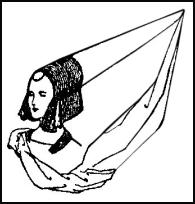
There is a gleam of truth in the representation, and you may see the real Jane Shore in a high steeple head-dress, with a thin veil thrown over it, with a frontlet or little loop of black velvet over her forehead; in a high-waisted dress, open in a V shape from shoulder to waist, the opening laced over the square-cut under-gown, the upper gown having a collar of fur or silk, a long train, broad cuffs, perhaps 7 inches long from the base of her fingers, with a broad, coloured band about her waist, a broader trimming of the same colour round the hem of her shirt, and in long peaked shoes.
In person of mean stature, her hair dark yellow, her face round and full, her eyes gray, and her countenance as cheerful as herself.
Hennin - The Steeple Headdress
Calthrop's - How To Make A Steeple Headdress - A Hennin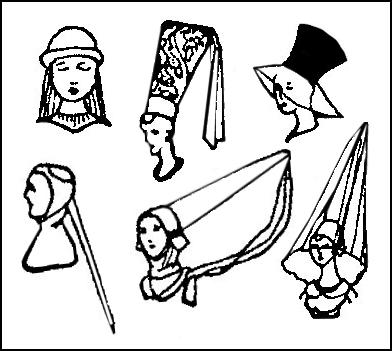
There are many ways of making the steeple head-dress. For the most part they are long, black-covered steeples, resting at an angle of forty-five degrees to the head, the broad end having a deep velvet band round it, with hanging sides, which come to the level of the chin; the point end has a long veil attached to it, which floats lightly down, or is carried on to one shoulder.
Sometimes this steeple hat is worn over a hood, the cape of which is tucked into the dress. Some of these hats have a jutting, upturned piece in front, and they are also covered with all manner of coloured stuffs, but not commonly so.
All persons having an income of £10 a year and over will have that black velvet loop, the frontlet, sewn into their hats.
How To Make A Cylinder Hat
There is another new shape for hats, varying in height from 8 to 18 inches. It is a cylinder, broader at the top than the bottom, the crown sometimes flat and sometimes rounded into the hat itself; this hat is generally jewelled, and covered with rich material.
The veils are attached to these hats in several ways; either they float down behind from the centre of the crown of the hat, or they are sewn on to the base of the hat, and are supported on wires, so as to shade the face, making a roof over it, pointed in front and behind, or flat across the front and bent into a point behind, or circular.
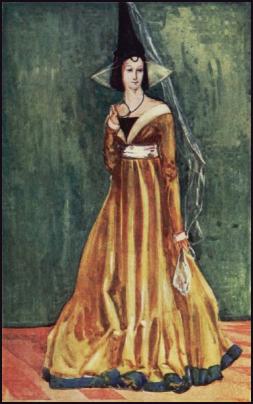
Take two circles of wire, one the size of the base of your hat and the other larger, and dress your linen or thin silk upon them; then you may pinch the wire into any variations of squares and circles you please.
A WOMAN OF THE TIME OF EDWARD IV - 1461-1483 - Right
The costume plate shows a lady wearing a steeple headdress - the high hennin from which hangs a wisp of linen. On her forehead is the velvet frontlet a veil stretched on wires across her forehead.
The veil was sometimes worn all over the steeple hat, coming down over the face, but stiff enough to stand away from it. Towards the end of the reign the hats were not so high or so erect.
Remember, also, that the horned head-dress of the previous reign is not by any means extinct.
There remain two more forms of making the human face hideous: one is the head-dress closely resembling an enormous sponge bag, which for some unknown reason lasted well into the reign of Henry VII as a variety to the fashionable head-gear of that time, and the other is very simple, being a wimple kept on the head by a circular stuffed hoop of material, which showed, plain and severe across the forehead. The simple folk wore a hood of linen, with a liripipe and wide ear-flaps.
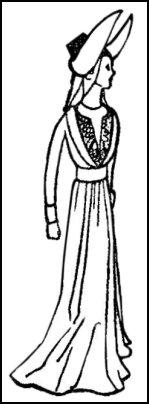
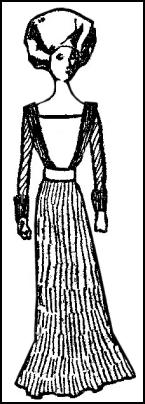
No doubt ladies were just human in those days, and fussed and frittered over an inch or so of hennin, or a yard or two of train. One cut her dress too low to please the others, and another wore her horned head-dress despite the dictates of Fashion, which said, 'Away with horns, and into steeples.'
No doubt the tall hennins, with their floating veils, looked like black masts with silken sails, and the ladies like a crowd of shipping, with velvet trains for waves about their feet; no doubt the steeples swayed and the silks rustled when the heads turned to look at the fine men in the days when hump-shouldered Richard was a dandy.
THE WOMEN
The River of Time runs under many bridges, and it would seem that the arches were low to the Bridge of Fashion in 1483, and the steeple hat was lowered to prevent contact with them.
The correct angle of forty-five degrees changed into a right angle, the steeple hat, the hennin, came toppling down, and an embroidered bonnet, perched right on the back of the head, came into vogue.
It is this bonnet which gives, from our point of view, distinction to the reign. It was a definite fashion, a distinct halt.
It had travelled along the years of the fourteenth century, from the wimple and the horns, and the stiff turbans, and the boxes of stiffened cloth of gold; it had languished in the caul and blossomed in the huge wimple-covered horns; it had shot up in the hennin; and now it gave, as its last transformation, this bonnet at the back of the head, with the stiff wimple stretched upon wires.
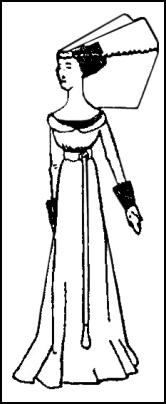
Soon was to come the diamond-shaped head-dress, and after that the birth of hair as a beauty.
In this case the hair was drawn as tightly as possible away from the forehead, and at the forehead the smaller hairs were plucked away; even eyebrows were a little out of fashion. Then this cylindrical bonnet was placed at the back of the head, with its wings of thin linen stiffly sewn or propped on wires. These wires were generally of a shape, the point at the forehead.
Left - A WOMAN OF THE TIME OF RICHARD III - 1483-1485
The costume plate shows the lower steeple headdress which is made of thin linen stretched upon wires; through this her jewelled cap and the embellishment is visible.
On some occasions two straight wires came out on either side of the face and so made two wings on either side of the face and two wings over the back of the head.
It is more easy to describe through means of the drawings, and the reader will soon see what bend to give to the wires in order that the wings may be properly held out.
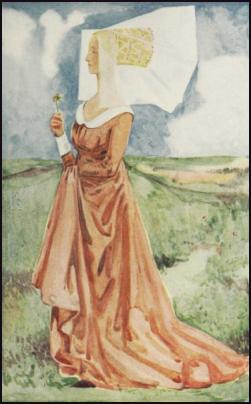
Beyond this head-dress there was very little alteration in the lady's dress since the previous reign. The skirts were full; the waist was high, but not absurdly so; the band round the dress was broad; the sleeves were tight; and the cuffs, often of fur, were folded back to a good depth.
The neck opening of the dress varied, as did that of the previous reign, but whereas the most fashionable opening was then from neck to waist, this reign gave more liking to a higher corsage, over the top of which a narrow piece of stuff showed, often of black velvet.
We may safely assume that the ladies followed the men in the matter of broad shoes. For a time the old fashion of the long-tongued belt came in, and we see instances of such belts being worn with the tongue reaching nearly to the feet, tipped with a metal ornament.
THE WOMEN
Take up a pack of cards and look at the queen.
You may see the extraordinary head-gear as worn by ladies at the end of the fifteenth century and in the first years of the sixteenth, worn in a modified form all through the next reign, after which that description of head-dress vanished for ever, its place to be taken by caps, hats, and bonnets.
A WOMAN OF THE TIME OF HENRY VII - 1485-1509
This is a sumptuous gown in rich elaborate material - good stuff - not any old fabric. Notice the diamond-shaped head-dress, the wide, fur-edged gown with its full sleeves. This is the start of new era - the Age of the Tudors.
This costume history page is about hair fashion history. It consists of a selection of women only headdresses and hairstyle illustrations with original text from 1327 to 1485 and taken from Calthrop's English Costume. They are as shown in individual Calthrop costume pages for specific eras on 36 other pages in another section of this website. The partial text copy is from the book ENGLISH COSTUME PAINTED & DESCRIBED BY DION CLAYTON CALTHROP.
This page is about female headdresses and hairdressing styles for the medieval era 1327 - 1485. Later eras of headdresses are shown on other pages. For the Introduction to this book see this introduction written by Dion Clayton Calthrop.
My comments are in italics.
Page Added January 2011. Ref:-P772.
